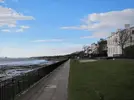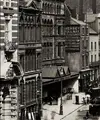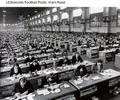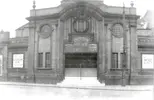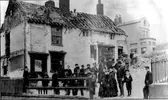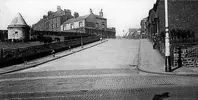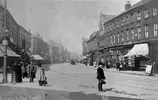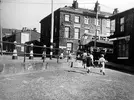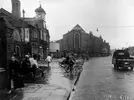Right my good lady found this area by Otterspool promenade - created by the slave trade she stumbled across this area - we had never heard of it ? never mind been there -Is it as prohibitive nowadays ?
When describing a Mersey estuary walk along the Garston shore, I wrote that, on arriving at the boundary of Garston docks, this as far as you can go: Garston Docks and the private residents only ? is it still like this -
Grassendale and Cressington Parks are 19th century gated private estates, built for wealthy Liverpool merchants in what was then open country. They were ‘carriage folk’ who had the means to travel to and from the city centre. Turn off the busy dual carriageway of Aigburth Road through the ornate sandstone gates and past the elegant sandstone lodge house and you enter a quiet enclave of Victorian mansions laid out in the early to mid 19th century along carriage ways both leading to an elegant riverside esplanade.

Cressington Park Lodge
But beware! Don’t attempt to bring your car down here. These are still private estates and on every lamp post there are warnings that if you are not a resident with a parking permit and you dare to park your car anywhere on these deserted avenues you will be hit with a substantial fine (£85, if I recall correctly). So I parked on Aigburth Road and walked down leafy roads past detached Victorian villas, no two alike, each standing in their own grounds.

This is a private park – there is no public right of way!
Grassendale and Cressington Parks, begun in 1845 and 1846, respectively, were the second and third of Aigburth’s gated riverside housing developments (Fulwood Park, which has the largest and most elegant houses, was the first). The residents even had their own railway station when the Cheshire Lines branch opened in 1861. Today, as a notice (above) warns, access to the station by non-residents remains a concession granted by the Trustees.

Cressington Park
Restrictive covenants relating to the size of plots, building lines, external materials and other design features continue to be enforced by Trustees of the Parks. Cressington Park consists, mainly of solid, but not particularly outstanding, red-brick Victorian villas, though I did notice several plots where modernist post-war dwellings had been erected. Had these been empty plots, or were earlier buildings demolished?

Cressington railway station
The railway station is one of the most desirable features of Cressington Park. The Liverpool Heritage Bureau describes it as ‘a splendid complex of buildings with elaborate details such as pierced bargeboards, half-hipped roofs, and curious eaves brackets’. Renovated by British Rail back in the 1970s, the cast iron canopy is now under threat of being
demolished, having fallen into disrepair.
Very few houses in the parks are of the same design, the most attractive being those built in the 1840s in Grassendale Park. Some have fine iron balconies and beautifully proportioned windows, doors and stucco details. The later Victorian and Edwardian houses are not as architecturally distinguished, but, as Pevsner has commented, ‘the whole area achieves unity and grace through a wealth of generous planting and mature trees’. As I neared the riverfront, I noticed that the parks also possessed a private tennis club. But perhaps what gave the parks their greatest exclusivity was having their own stretch of river promenade.

Grassendale Promenade: early 20th century postcard
The view from the eastern end of Cressington esplanade is not so elegant: razor-edged fencing and floodlights mark the boundary of Garston docks. At its height, over 1000 people were employed at Garston Docks and on the miles of railways that serviced and connected them. Victorian Garston bore no resemblance whatsoever to the rural village had once been. Public health, hygiene, and living conditions were desperately poor, and the working environment was dangerous and hard. By 1937, there were 93 miles of railway sidings serving the docks, with 8 miles of these running alongside the quays.
